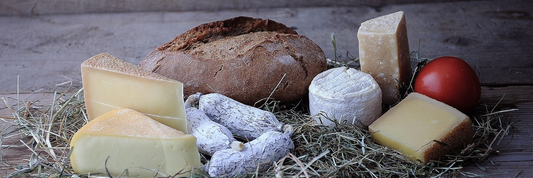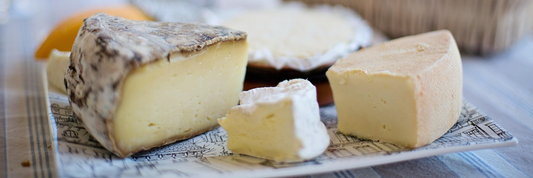Learn how to grate Parmesan cheese like a pro! Discover why freshly grated Parmesan tastes better than pre-grated, common challenges you might face, and simple tips and techniques to get perfect, flavorful shavings every time.
- Types of Parmesan Cheese: Varieties, Uses & Storage Tips
- How to Use Parmesan Cheese Like a Pro
- How to Store Parmesan Cheese for Maximum Freshness
- How to Cut Parmesan the Right Way
Why Grating Fresh Parmesan Cheese Matters for Flavor and Quality
Grating fresh Parmesan cheese is a small step that delivers a big impact on the taste, texture, and overall quality of your dishes. Unlike pre-grated Parmesan, which often contains additives like anti-caking agents and preservatives, freshly grated Parmesan is pure, natural cheese that melts beautifully and bursts with authentic flavor.

Key Reasons to Choose Freshly Grated Parmesan:
- Superior Flavor: Fresh Parmesan releases intense nutty, savory notes that pre-grated cheese can’t match. Additives in pre-grated cheese can mute these vibrant flavors, making your dishes less flavorful.
- Better Texture: Freshly grated Parmesan melts smoothly, enhancing sauces, pastas, and soups with a creamy, silky consistency. Pre-grated varieties tend to clump, leaving a dry or powdery texture.
- No Additives or Fillers: Avoid anti-caking substances such as cellulose and potato starch which can alter taste and mouthfeel.
- Cost-Effective and Fresher: Buying Parmesan in block form and grating it yourself is often more economical and guarantees fresher cheese, improving the overall culinary experience.
- Versatile Use: Fresh Parmesan elevates not only pasta but also salads, baked goods, and soups, adding a rich umami depth and appealing texture.
In pasta dishes, freshly grated Parmesan melts perfectly to create a luscious sauce that clings to every strand, boosting umami and satisfaction. In salads, it adds a subtle crunch and brightness, balancing fresh greens with a rich, savory accent. For baked goods, freshly grated Parmesan incorporates into dough or toppings, enhancing moisture and flavor far beyond what pre-grated cheese can achieve.
By grating Parmesan cheese fresh, you unlock the cheese’s full potential delivering richer aromas, creamier textures, and deeper flavors that take everyday meals to the next level. Making the switch is one of the simplest ways to improve your cooking and impress your guests with authentic Italian taste.
Best Way to Grate Parmesan Cheese
Grating Parmesan cheese with the right method unlocks its fullest aroma, flavor, and texture. Each grating tool creates a unique result and experience, impacting how Parmesan enhances your dishes. Here’s a more in-depth look at the most effective approaches, their advantages, drawbacks, and kitchen best practices:
Microplane or Zester – Fine, Fluffy Shavings
Step-by-step guide:
- Start with a chunk of room-temperature Parmesan, as slightly softened cheese grates more easily and evenly.
- Place your microplane or zester over a bowl, cutting board, or directly above a hot plate of pasta to catch the delicate shavings.
- Hold the block at a slight angle and use long, smooth strokes. Avoid pushing too hard; let the sharp blades do the work.
- After several strokes, tap the microplane gently to dislodge any cheese caught in the grater.
- Continue rotating the block to expose fresh edges, ensuring you use up most of the cheese and produce even, powdery flakes.
Freshly microplaned Parmesan is excellent as a "finishing cheese" sprinkle it atop risottos, salads, creamy soups, grilled vegetables, or even popcorn for a burst of salty umami.
Pros:
- Releases the cheese’s deepest flavor notes due to increased surface area.
- Perfect for incorporating into delicate dishes where texture matters, such as soufflés or vinaigrettes.
- Compact size fits any kitchen setup, from small apartments to professional restaurants.
Cons:
- Fine shavings can melt instantly on hot foods, so you might lose some texture if not served immediately.
- Not ideal for dishes needing substantial, “bitey” cheese texture (like gratins or hearty bakes).
- Small size limits efficiency if grating a large quantity for a crowd.
Box Grater – Thicker, Robust Gratings
Step-by-step guide (expanded):
- Choose which side of the box grater to use: large holes produce chunky shreds, while medium holes provide classic grated cheese.
- Place the box grater on a stable cutting board and grip it firmly by the top handle.
- Use straight downward motions, being careful as you reach the end of the cheese to protect your fingers.
- Pause periodically to gather grated cheese from inside and underneath the grater, ensuring nothing is wasted.
- For best results, grate right before using to maximize flavor and avoid clumping.
Box graters are versatile they’re great not just for Parmesan but also for semi-hard and soft cheeses, veggies, chocolate, and more.
Pros:
- Lets you decide on the shred size best for your dish a larger shred for texture on baked pastas or casseroles, or medium shreds for sandwiches and salads.
- Works well for grating enough cheese to serve a family meal or to prep for cooking in bulk.
- Sturdy and reliable for everyday kitchen use.
Cons:
- Finger safety is a concern: always watch your grip and consider protective gloves for large quantities or for children helping in the kitchen.
- Harder cheese can require more effort and arm strength, potentially making repeated use tiring.
- Cleaning can be tricky, especially with sticky or oily cheese residue stuck in corners; rinsing immediately after use helps.
Rotary Cheese Grater – Efficient for Large Quantities
Step-by-step guide:
- Often used at the table in Italian restaurants, rotary cheese graters are practical and quick for grating plenty of cheese with minimal mess.
- Place a wedge or chunk of Parmesan in the grater’s hopper.
- With one hand, press down using the handle or cap to hold the cheese in place; with the other, crank the rotary handle in a steady motion.
- Cheese is grated against a drum, falling out as consistent shreds straight into a bowl or over food.
- Refill the hopper as needed if grating for a dinner party or storing extra in an airtight container.
Rotary graters are also terrific for hard cheeses beyond Parmesan, such as Pecorino Romano or Grana Padano.
Pros:
- Exceptionally efficient for prepping large amounts without fatigue.
- Very safe hands stay far from blades, so it’s even suitable for kids (with supervision).
- Grates directly onto food, which is great when serving guests and wanting to provide freshly grated cheese tableside.
Cons:
- Takes up more space in drawers or cupboards.
- Disassembly may be needed for cleanup, requiring thorough washing and drying to prevent cheese residue buildup.
- Costlier than handheld graters; ideal for serious home cooks and cheese lovers.
Choosing the Right Grating Tool for Parmesan Cheese
Selecting the best grating tool for Parmesan cheese depends on several important factors including the texture you desire, the quantity you need to grate, and how easy the tool is to use and clean. Different tools serve different purposes, so choosing the right one can significantly enhance your cooking experience and the final dish quality.

Key Factors to Consider
- Desired Texture:
Do you want fine, fluffy Parmesan powder that melts quickly and blends into sauces, or coarser, thicker shreds that add texture and visual interest? Tools like microplanes yield very fine gratings, while box graters and rotary graters offer thicker results. - Quantity:
For small amounts or finishing touches, a handheld microplane or zester works best. If you regularly grate large batches for meals or entertaining, a rotary grater can grate quickly and efficiently without fatigue. - Ease of Use and Cleanup:
Consider grip comfort, stability, and safety especially when handling hard cheese. Also think about how easy the tool is to clean; many microplanes and box graters are dishwasher-safe and simple to rinse, while rotary graters may require disassembly and more thorough cleaning.
Tool Comparison Table: Microplane vs Box Grater vs Rotary Grater
|
Feature |
Microplane / Zester |
Box Grater |
Rotary Grater |
|
Texture |
Very fine, fluffy shavings |
Medium to coarse shreds |
Medium-thick, consistent shreds |
|
Best For |
Finishing touches, delicate flavor addition |
Everyday use, versatile for various shred sizes |
Large quantities, frequent use |
|
Ease of Use |
Easy, requires wrist action, less effort |
Moderate effort, requires stable grip |
Minimal effort, crank handle operation |
|
Safety |
Blade exposed, requires care to avoid cuts |
Blade exposed, can be risky as cheese runs low |
Safer hands-away-from-blades design |
|
Cleaning |
Quick rinse or dishwasher safe |
Dishwasher safe but can trap cheese in corners |
Requires disassembly; careful cleaning needed |
|
Portability / Storage |
Compact, easy to store |
Bulky, needs adequate storage space |
Bulky, needs dedicated storage space |
|
Cost |
Generally inexpensive |
Inexpensive to moderate |
More expensive |
|
Special Notes |
Ideal for smooth textures and delicate garnishes |
Versatile; good for different shred sizes |
Great for high volume, restaurant-style use |
How to Grate Parmesan Cheese Without a Grater
If you don’t have a traditional cheese grater on hand, don’t worry, there are simple, effective alternatives to grate Parmesan cheese with tools you probably already have at home. These methods help you achieve the lovely texture and flavor release of grated Parmesan without needing a specialized grater.
Using a Sharp Kitchen Knife to Shave Thin Slices
One of the most straightforward alternatives is carefully slicing Parmesan thinly with a sharp kitchen or chef’s knife. Start by cutting a manageable block of cheese, then slice thin, even sheets off the edge. You can then stack a few slices and cut them into thin matchstick-like strips or even finely dice them. This method gives you control over slice thickness, perfect for salads or toppings where a delicate texture is preferred.
Peeler Method for Larger, Rustic Flakes
A vegetable peeler is great for creating rustic, larger Parmesan flakes. Simply run the peeler down the edge of a Parmesan block, turning it slightly with each pass to get even slices. These flakes add a beautiful texture to salads, pastas, or cheese boards. To prevent sticking, lightly spray the peeler with cooking spray or wipe it occasionally during use.
Food Processor with Shredding Blade
If you own a food processor, you can grate Parmesan quickly and efficiently. Cut the cheese into small cubes that fit through the food processor feed tube or directly into the bowl if pulsing by hand. Attach the shredding disk or use the regular blade to pulse until the cheese reaches the desired size. Be careful not to over-process, which can turn the cheese into mush. This method is ideal when grating larger quantities for cooking or gatherings.
Emergency Hack: Break Parmesan into Crumbles by Hand
In a pinch, you can break hard Parmesan chunks into small crumble-sized pieces simply by hand. This works well for sprinkling over salads or dishes where a finer grate isn’t essential. The natural crumbly texture of aged Parmesan makes this feasible, though the texture will be chunkier and less uniform than grated cheese.
Visual Step-by-Step Images Recommended
For blog readers, including clear, step-by-step images of each method knife slicing, peeling, food processor use, and hand crumbling helps illustrate technique and gives confidence in attempting these alternatives.
Parmesan Cheese Grating Tips for Best Results
Grating Parmesan cheese effectively takes a bit of technique and care, helping you unlock the cheese’s full flavor and texture while making the process easier and more enjoyable. To get the best results every time, follow these essential tips:
Chill the Cheese Slightly for Easier Grating
Parmesan cheese is a hard, aged cheese, which can sometimes be challenging to grate when at room temperature because it may become too soft or crumbly. Placing the cheese block in the refrigerator for about 15 to 30 minutes before grating firms it up slightly, making it easier to handle and grate cleanly. Chilled Parmesan tends to grate into more uniform shreds and flakes without breaking apart or smushing under pressure.

Use Firm, Steady Pressure with a Microplane
When using a microplane or zester, applying consistent firm pressure is key to achieving fine, fluffy Parmesan shavings. Avoid pressing too lightly this can lead to uneven grating or clogging while also not pressing so hard as to risk slipping or injury. Use long, smooth strokes against the cheese block and rotate the cheese gradually to expose fresh surfaces. Keeping a balanced grip and smooth motion allows the sharp teeth of the microplane to do the work efficiently and safely.
Clean Tools Immediately After Grating to Avoid Stuck-On Residue
Parmesan cheese has natural oils and proteins that can quickly adhere to grating tools, especially microplanes and box graters. Cleaning your grater or peeler immediately after use prevents hardened cheese residue, which can be difficult to remove once dried. Rinse the tool under warm water and gently scrub with a brush or sponge. For microplanes, tapping the grater on the edge of the sink or wiping with a cloth while rinsing helps dislodge trapped bits. Prompt cleaning saves time, maintains tool sharpness, and ensures hygiene in your kitchen.
How to Store Grated Parmesan Cheese Properly
Proper storage of grated Parmesan cheese is essential to maintain its fresh flavor, texture, and quality over time. Whether you’re saving leftovers for a few days or preserving larger quantities long-term, following the right techniques can prevent spoilage, moisture buildup, and clumping.
Short-Term Storage: Airtight Container and Refrigeration
For everyday use, store grated Parmesan in an airtight container or tightly sealed jar to protect it from exposure to air and moisture. Glass or BPA-free plastic containers with secure lids work well. Place the container in the refrigerator, ideally in the main compartment rather than the door, where temperature fluctuations are less frequent. This helps keep the cheese fresh for about 1 to 2 weeks.
To further minimize moisture and clumping, consider placing a small piece of parchment or wax paper inside the container lid or lightly dusting the cheese with a pinch of fine flour or cornstarch before sealing.
Long-Term Storage: Freezing Grated Parmesan
If you have a large amount of grated Parmesan or want to extend its shelf life beyond a couple of weeks, freezing is an excellent option. Portion the cheese into small servings and place them in freezer-safe, airtight containers, resealable bags, or vacuum-sealed pouches to prevent freezer burn.
Frozen grated Parmesan can last up to 6 months. When you need to use it, simply thaw the amount required in the refrigerator or sprinkle it directly onto hot dishes where it will quickly soften and melt without losing flavor.
Avoiding Moisture and Clumping
Moisture is the primary enemy of grated Parmesan: it can cause clumping, spoilage, and texture degradation. Always use dry utensils when scooping cheese and avoid leaving containers open unnecessarily. After grating, handle the cheese in a clean, dry environment, and ensure containers are completely dry before filling.
To reduce clumping, you can gently toss the cheese with a small amount of starch (such as cornstarch or arrowroot powder) especially if storing for a longer time, although this is optional if the cheese is used quickly.
Eco-Friendly Packaging Suggestion
For an environmentally conscious storage option, consider using small kraft paper boxes instead of plastic containers or bags. These sustainable cheese packaging solutions help reduce plastic waste while keeping your grated Parmesan protected and fresh.
Contact us now to find the right sustainable packaging for your needs.
Conclusion
Choosing the right tool and method to grate Parmesan cheese greatly enhances your dishes’ flavor and texture. Whether you prefer fine shreds from a microplane, thicker gratings from a box grater, or quick bulk grating with a rotary grater, freshly grated Parmesan delivers richer taste and better meltability than pre-grated options.
Follow simple tips like chilling the cheese before grating and cleaning tools promptly for best results. Proper storage and eco-friendly packaging also help keep your Parmesan fresh and flavorful. By grating Parmesan fresh and storing it properly, you can enjoy authentic, delicious dishes every time.







